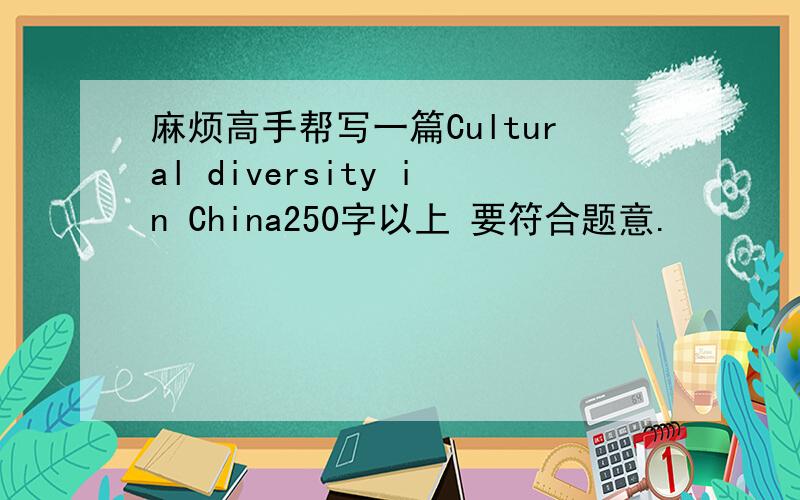麻烦高手帮写一篇Cultural diversity in China250字以上 要符合题意.
来源:学生作业帮助网 编辑:作业帮 时间:2024/11/20 03:33:58

麻烦高手帮写一篇Cultural diversity in China250字以上 要符合题意.
麻烦高手帮写一篇Cultural diversity in China
250字以上 要符合题意.
麻烦高手帮写一篇Cultural diversity in China250字以上 要符合题意.
New Year traditions reflect Chinese cultural diversity
TAIPEI,Taiwan -- As they have for thousands of years,on the night of Feb.6,millions of people across Taiwan and much of Asia will be cramming the roads,highways,and trains to make it back to their parents’ homes in time for the Chinese Lunar New Year’s Eve celebrations.Over time,a multitude of traditions have become part of the New Year celebrations that encompass Taiwan and China’s diverse history and people.While many different stories exist,according to legend,the practice of coming together on New Year’s Eve began as a way to protect against Nianshou~,or “year beast.” This beast is said to be unable to look at the color red and to be afraid of loud noises.The custom of hanging red spring couplets or chunlian,around the front door before the New Year has its origins in this story,as they are to prevent the beast from entering the home.Further,to prevent the beast from attacking,a family would come together to make loud noises late into the evening.
Today,while most people are not afraid of Nianshou,family members still gather on New Year’s Eve for a large meal and stay up late into the night playing mahjong,watching television or simply chatting.Those who are married give red packets,or hongbao,with money inside to unmarried members of the family.While the amount of money varies,it is always important that it makes an auspicious number or combination,such as eight,or pairs of numbers (e.g.two NT$100).As midnight arrives,families light loud firecrackers to mark the coming of the New Year.
As with most holidays,food plays an important role in the New Year celebrations.Many dishes are eaten during the New Year because they are seen as symbols of good luck and ensure prosperity for the coming year.For example,fish (yu) represent “having enough to spare,” fish and meat balls (yuwan and rouwan) symbolize “reunion,” and garlic chives (jiucai) mean “everlasting.” Families also prepare a New Year’s cake (niangao),which when it rises signifies “advancement toward higher prosperity.” Finally,families also usually eat dumplings because they look similar to silver ingots,and those that eat them are said to have wealth in the New Year.
Along with New Year’s Eve celebrations,there are customs and traditions that are practiced during the following 15 days,together know as Spring Festival (chunjie).On the first day it is important to wake up early and welcome in the New Year,the streets flooded with people out to send New Year’s greetings and wishes.During the second day,married women are to return to their parents’ house in order to offer good wishes for the New Year.
A common belief is that daughters returning home on the first day will bring poverty to the family.The fourth day is the day to “greet the gods,” (anshen),and families across Taiwan will prepare gifts of fruit,wine and other delicacies to welcome and honor the gods back into their homes.On the fifth day,markets and businesses start up again and celebrate the New Year.On the ninth day,numerous offerings are set out in temples to celebrate the birthday of the Jade Emperor,who is believed to have been born right after midnight on the ninth day.Finally,the 15th and final day of the Spring Festival is the Lantern Festival.On this day,decorative lanterns are put up all around the island.
Of course,as society has changed,so have traditions.“These days more and more people are traveling abroad during the New Year holidays,” said Chen Tsu-chi,33,a teacher in Taipei.With the growing reach of the Internet,more and more people are sending their New Year’s wishes online,no matter where they are in the world.Nevertheless,even if one does not make it home on New Year’s Eve,a place setting will still be put out for you,so at least in spirit you can be home for the holidays.